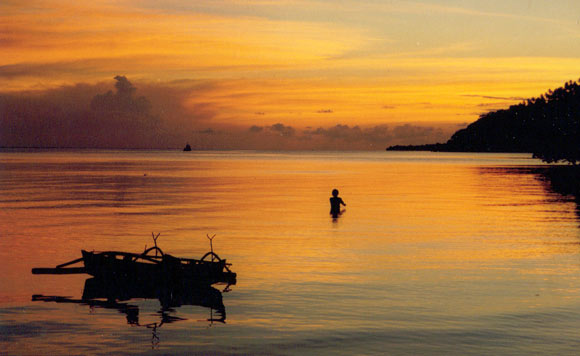I picked the worst possible time for a trip to Sulawesi. It was Idul Fitri - the end of Ramadan where people all over Indonesia are on the move. I had managed to get a ticket on the Pelni ferry from Java. According to the literature - the boat 'the Kerinci' was more like a cruise liner - I was very impressed with the pictures of the well laid out and clean cabins. As it happened I wasn't even to see a cabin. the only ticket I had managed to secure was 'deck' class - a euphamism akin to standing room on a bus - only this trip lasted 24hours. Every last inch of space of the entire ship was occupied. The lifeboats, the stairs, everywhere. One family who had sequestered a few chairs allowed me the rare privilege of sleeping under them. The one (and only one) bonus of the trip was that everyone was very friendly - as is usual I find under the most trying of circumstances. It didn't however assuage my fears that if we met any sort of rough sea, all of the hundreds of people piled on this heap of scrap metal would surely die. As it happened we arrived not too late in Ujung Pandang and I said my good-byes to my surrogate family and headed down the gangplank, happy to have arrived despite the torrential downpour that had heralded our arrival.
Ujung Pandang was an interesting place - not least in the 17th century - when apparently it was usual for the men to wear penis balls (I don't know what they are either) and the women to wander around almost naked. It was also famous for the Bugis - who were and remain, famous sailors of Sulawesi and whose wildness gave rise to the English term 'Bogeyman'. Ujung Pandang also used to known as Macassar - after the oil of the same name, strangely enough the name continues in the word antimacassar - the piece of cloth on the top of high backed chairs which protect them from getting covered in hair (macassar) oil.
Nowadays however, UP is a dreary place and I like most other tourists I quickly left for more interesting pastures and the highlight of Sulawesi - Toraja land.

my route (March 1997)
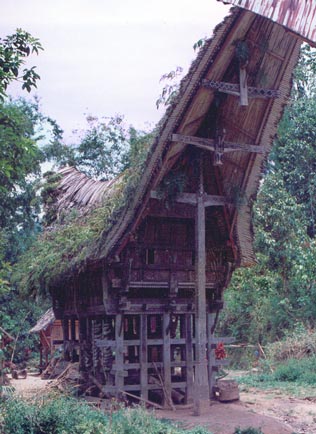

The picture above shows a typical house of the Toraja region. Shaped rather like a boat and similar to ones found in Sumatra. Local mythology maintains that the Toraja originated from another island and after a long journey across the sea were driven by a storm to the shores of Sulawesi and then up river to the mountains where they now live. The boat shaped houses remind them of their origin as islanders.
Toraja land is a limestone area and so there are many caves. Many are sacred and where many coffins are to be found as in the picture above right - the so-called hanging coffins.
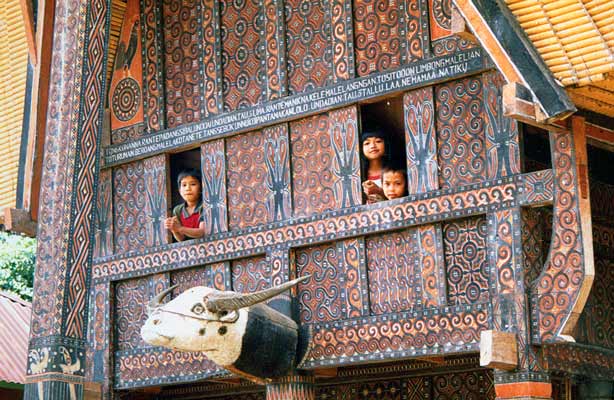
The main town in the Toraja region is Rantepao, but I chose to stay in a small village a few kms away in a traditional homestay ran by Mama Siska. The photo above is of her house and children.
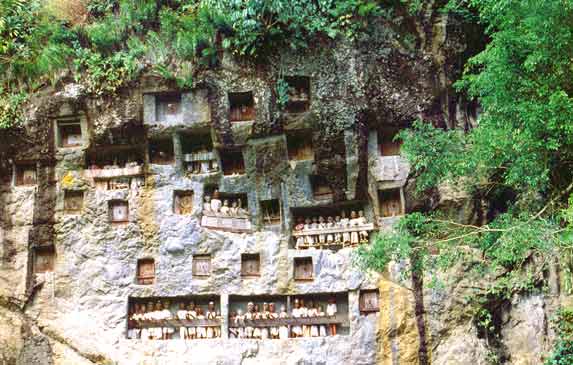
Nowadays people don't leave their coffins in caves, but excavate tombs high up inaccessible limestone cliff faces. An effigy of the dead person (a tau tau) is then placed in one of the galleries.
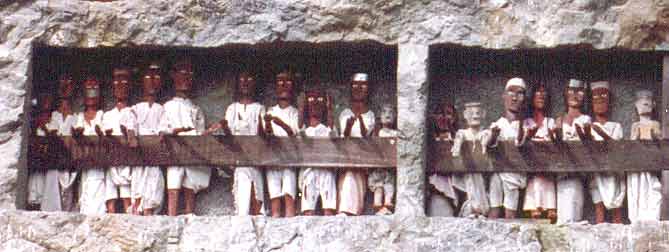
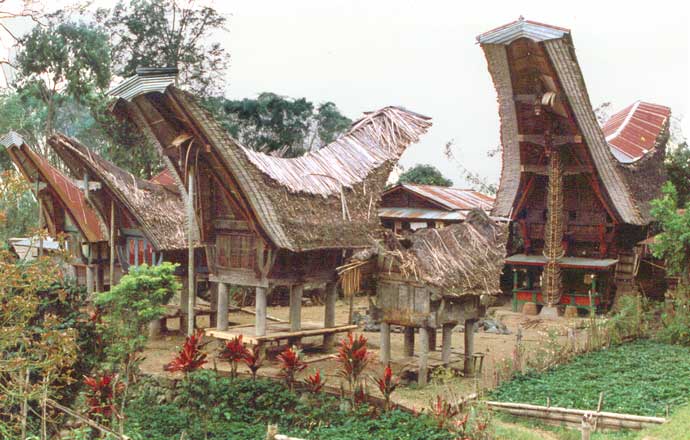
Above is a picture of a small village. Note the small rice barn on the right.
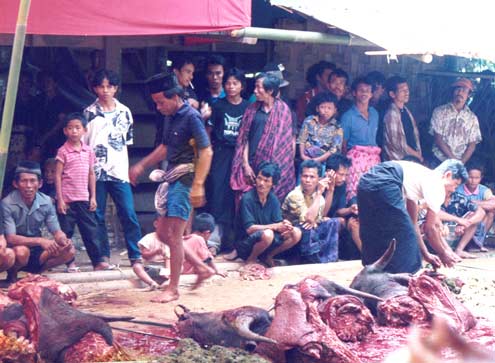
The Toraja people are famous throughout Indonesia for their elaborate funeral rituals. The cost of which can be financially crippling for the family concerned. The dead person is dressed up and later cocooned in multiple layers of funeral shroud. The body then remains in the house until the family can afford the funeral. There are many rites, but the photos above and below are of the final ceremony - the ritual slaughter of the buffalo. The funeral I went to was ofquite a famous man and so the place was awash with blood as buffaloes were led into the centre area and slaughtered. Meanwhile ladies gently stepped over the blood and gore delivering tea to the guests. In the photo below you can see the family of the deceased and the coffin, looking down from a platform. There has to be many guests for an important man and everyone leaves with a plastic bag full of meat - and that's why it gets so expensive.

After the excitements of Toraja Land, the road (if you can call it that) wound its way through some of the most beautiful and unspoiled rainforests in Indonesia until finally arriving on the shores of Lake Poso. The lake area is very sparsely populated and is home to some very rare fauna. 67% of the species of the area are endemic and I'm sure there haven't been that many studies done so lots more new ones are bound to be discovered.
In the centre of Sulawesi (around Poso) the population is roughly half Christian half Moslem. The Moslems mainly immigrants from overpopulated Java. When I was there (1997), there was some unrest between the two groups but it was still safe to travel. However more recently (2005) the ethnic tension erupted, resulting in a number of deaths and a dangerous place for tourists.
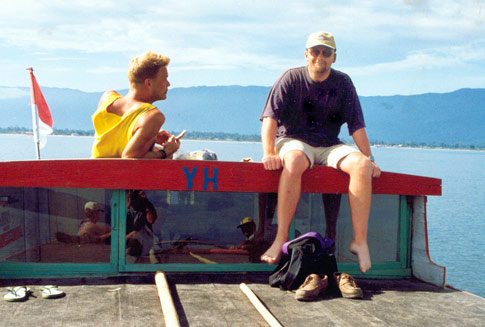
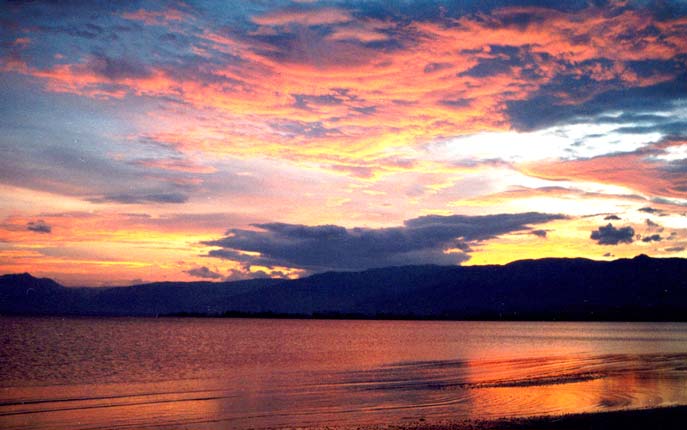
After Poso, and a number of inauspicious little towns, I arrived at Ampana and embarked on the ferry to the Togian Islands. It must be said it would have been rickety for a two or three hour journey - but this one was overnight. There was a bridge occupied by the captain and the first mate, but otherwise the passengers had to either find a piece of deck space or go in the hold and sit on the sacks of produce that were accompanying us. The following morning we arrived at Wakai -the only town of the Togians - and a wild west town it was. As there were four foreigners on board we were soon found by Mr. Big (that's what his business card said) and he convinced us to go on his outrigger canoe and stay at his Paradise bungalows on a nearby island. As it happens it wasn't misnamed - there were seven bungalows on a pristine white beach on a small island miles away from civilization.
Below is my 'paradise cottage' on Kadidiri Island
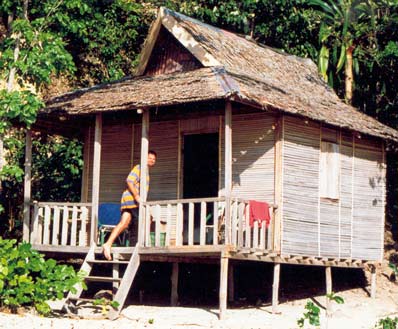
I spent a week on Kadidiri Island (there was only one ferry a week) - but I had a great time. I went diving - which despite the rudimentary safety conditions, was absolutely amazing - pristine waters and coral untouched by humans. Added to that there was a complete W.W.II bomber in 20 metres of water which looked fabulous. I also went exploring around the tiny island in a dug out canoe and visited the local sea gypsy village. (Below is a picture of the kids from there). We had one unwelcome visitor - a crocodile, which was fortunately captured and surprisngly, or so I thought, it was taken away to be released on a more outlying island.

Mr. Big's luxuriously appointed diveboat



Wakai jetty
After a week in paradise I was back on the ferry. This time I got to chat to the captain - a rather comical fellow who doesn't direct things from the bridge but sits in a high chair on the deck and directs things through a megaphone. But he is professional - after all he does have a captain's hat with an anchor on the front. He is very proud of his boat of course - it has all the modern requirements - compass, steering wheel and fairy lights strung around the bridge. I thought it best not to ask about a radio or life jackets never mind lifeboats. Anyway, it was another overnight journey and we headed off into the sunset with a pleasant breeze and soon I drifted off to sleep. I was rudely awakened however by a dangerous lurching of the boat. Fortunately we seemed to be close to the shore, and in actual fact we had hit a reef coming into a small port. By morning it had become apparent that our steering was broken. I went ashore and left the matter in the capable hands of the captain and his team. While ashore I took this photo of some kids playing football with the most amazing jungle backdrop. It took a surprisingly short amount of time to get things fixed and we were once again off into the open sea. Later on in the afternoon I was greatly relieved to spot land, but this was short lived as it became apparent that without any navigation instruments the captain really had no idea where we were. We therefore spent another four hours following the coast until we reached our final destination - the port of Gorontalo.

After the rest of Sulawesi, Manado comes as a bit of a shock. It is noisy and brash as if influenced by the Philippines, a few hundred miles to the north. It is in fact by Indonesian standards quite wealthy; a result of its agricultural products: cloves, nutmeg, coconuts and coffee, but also increasingly tourism - attracted by the world famous coral gardens of Bunaken, an island just offshore. Northern Sulawesi is also famous for its animals, not only in the Tangkoko Batu Angus National Park but also on offer in its restaurants and markets.



Above - rats, left - bats and above left - a dog, all local delicacies. (It is a fact that dogs are eaten in many places in Indonesia, Philippines and Vietnam as well as China and Korea).
Crested Black Macaques

The Tangkoko Batu Angus National Park is quite small but is home to many endemic species. I hired the services of a local park warden and was very pleased I did. I've often walked in jungles and not seen a thing. But every few minutes he would stop and then point into the forest. I would see nothing until he guided me further and then reveal to me a snake, toucans, the quite rare bear cuscus and all sorts of insects. However it was the monkeys for which the place was famous. We could hear them in the trees and after cutting through the dense jungle my guide suddenly broke into a run. I followed. 'There' he whispered. Of course I saw nothing . But as we waited, the leaves started rustling all around us and before long it became apparent that a whole troop of the rare crested black macaques had come down out of the trees and were now walking right past us as if we weren't there. By now it was getting dark and we hadn't seen the main prize - the large eyed jumping Tarsier. In the darkness I wasn't even sure that my guide could lead us back to civilization. But then suddenly he stood stock still and pointed out into the gloom. I switched on my torch where he had pointed and less that four feet away I saw the startled face of our quarry, paralyzed in the torch beam and smaller than the palm of my hand.
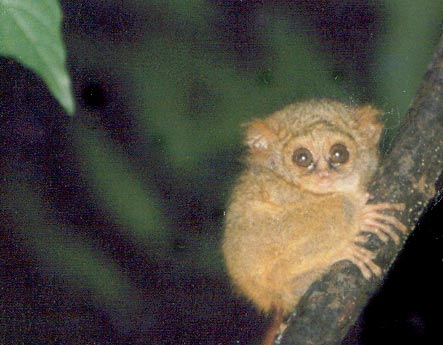
Indonesia is one of the best places in the world to see volcanoes. Every island has at least a few smoking at any one time. This one is Mt. Mahawu, not far from Tomohon in Northern Sulawesi.

One of the most famous dive sites in the world is Bunaken island. Here you can stay in a beach hut for a few dollars and then snorkel a few metres offshore to one of the most diverse coral ecosystems in the world. Add in spectacularly deep coral drop offs and therefore the appearance of pelagics such as barracuda and killer whales and you've got the ultimate climax to a great island destination. Oh, and the sunsets are quite good as well...
